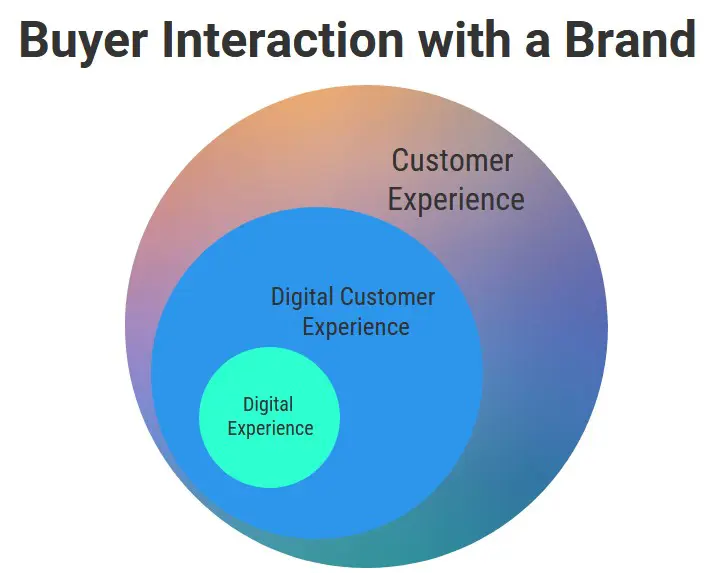What is a digital experience, and how does it apply to your business?
With almost 70% of customers prioritizing convenience over the brand, the digital experience plays a significant role. So, what is it, and how can you use it?

Did you know that almost 70% of customers prioritize convenience over brand when shopping? In this regard, the digital experience plays a significant role in the customer journey.
Companies that improve the digital experience for their shoppers see increased customer loyalty and revenue.
So, what is a digital experience, and what facets of your business can benefit from it?
Key takeaways:
-
A digital experience is one electronic interaction that a customer has with your company.
-
Digital customer experience differs from DX because it is the sum of the user’s digital interactions with a company throughout their buyer journey.
-
Customer experience is every interaction a buyer has with your brand, online and offline.
-
To improve digital experiences, start by collecting customer feedback and analyzing the data.
-
Two areas that should be flawless are website response time and mobile app performance.
What is a digital experience?
A digital experience, also known as DX, is any digital interaction that a customer has with any of your company’s digital touchpoints. Examples of digital experiences are:
-
A customer sees an email announcing a sale.
-
A user browses a company’s website and reads digital assets like case studies or webinars.
-
A person scrolls through their social media account and sees an ad.
-
A customer interfaces with a chatbot to receive answers regarding a product.
-
A person works with a customer service agent via chat to resolve an issue.
-
A customer gets a notification on their smartphone that their product has arrived.
-
Someone finds and clicks the link to a blog from a Google search.
-
A buyer scans and pays for their products at a store’s checkout kiosk.

Digital experience vs. digital customer experience vs. customer experience
You may wonder: “Aren’t digital experience and digital customer experience the same thing?” Or perhaps: “What’s the difference between digital experience and customer experience?” There are slight differences between each.

-
Digital experience vs. digital customer experience
As we learned, a digital experience is one electronic interaction that a buyer has with your company. On the other hand, a digital customer experience is the sum of the user’s digital interactions with a company throughout their buyer journey.
As an illustration, let’s take a buyer called Carol. Carol loves a particular brand of dishwashing soap and follows the brand on social media. When scrolling through her social media, she sees that her favorite soap is on sale. Carol clicks on the ad from her phone, and the link switches to the product page of the brand’s app, where she’s already logged in. She adds the soap to the cart but doesn’t complete the purchase. Later that day, when sitting at a computer, Carol goes to the brand’s website and completes the checkout process. Finally, Carol checks the option to deliver the soap each month automatically.
When Carol saw the ad for the dish soap on social media, that was a digital experience. The entire process ending with Carol subscribing to monthly deliveries of the product was the digital customer experience.
-
Digital experience vs. customer experience
Since digital experience is one digital interaction and digital customer experience is the whole digital journey, what is customer experience? Customer experience is every interaction a buyer has with your brand, online and offline. Perhaps they browse through a printed brochure or purchase an item inside a physical store. These interactions aren’t digital but are also part of the buyer’s journey with your brand.
3 ways to improve the digital experience for your customers
A great digital experience builds customer relationships, delivers on customer needs, creates differentiation and helps digital marketing teams scale their goals and initiatives.
Companies now need to have an experience management strategy that extends to all their digital service providers in order to harbor a truly customer-centric brand ethos.
With a clear understanding of an omnichannel digital experience, let’s look at ways to enhance how the customer interfaces with your brand.
-
Collect and analyze customer feedback
First, it’s imperative to understand your customer’s pain points when using your digital channels. To that end, collect customer data. Here are some ways:
-
Send a survey – When requesting customers to fill out a survey, offer them some compensation for their time and energy. A small reward will increase the number of respondents and inspire customers to provide their honest feedback.
-
See what customers say on social media – Listen to the discussions about your brand to gain insights into how people feel about interacting with your company.
-
Conduct a face-to-face interview – This old-school approach still has benefits in that you can learn a lot from non-verbal communication when interacting in person. You don’t need a large pool of participants to try this method.
Once you’ve collected the information, analyze the data to see where you can make improvements in your users’ digital experiences.
-
Decrease load time
A little over 50% of customers believe that a page shouldn’t take more than three seconds to load, and pages that load slowly are the top source of frustration for one in five online shoppers. So, an important area to improve to provide a high-quality digital experience is decreasing your website’s load time.
There are many ways to speed up web page load times. Here are just a few:
-
Verify your dedicated web hosting services have the latest and fastest hardware (e.g., CPU, memory and disks).
-
Don’t have too many and too large images on your site. Enable image compression.
-
Enable browser caching.
-
Boost performance for mobile
In 2021, almost 73% of all retail ecommerce came from m-commerce, meaning online shoppers made purchases from their mobile phones. For that reason, mobile app performance is one of the top areas to ensure pleasing digital experiences.
How can you deliver excellent mobile user experiences? Here are a few tips:
-
Verify functionality – Can the user complete their desired task on the mobile app, or do they have to revert to the website?
-
Make searching easy – Provide filter options or even a barcode scanning option to facilitate their search.
-
Simplify the checkout process – Users don’t want to be holding their phones in one hand and a credit card in the other and inputting information. Have their credit card information ready as a billing option if they are logged in. Or provide alternate payment methods like PayPal or Apple Pay.
Deliver superior digital experiences with Optimizely
Suppose you want to connect the full digital journey, personalize experiences and leverage digital as the main branch of your business. In that case, Optimizely’s Digital Experience Platform (DXP) can help with digital transformation. DXP is an integrated set of core technologies that support the creation, management, delivery and optimization of digital experiences.
Contact Optimizely today to see how we can help you deliver superb digital experiences.
